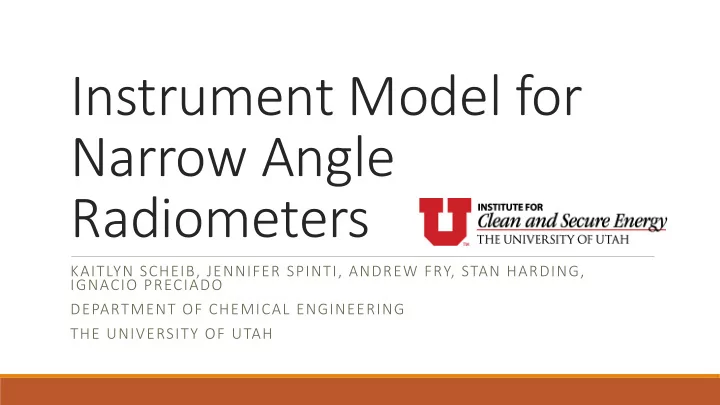

Instrument Model for Narrow Angle Radiometers KAITLYN SCHEIB, JENNIFER SPINTI, ANDREW FRY, STAN HARDING, IGNACIO PRECIADO DEPARTMENT OF CHEMICAL ENGINEERING THE UNIVERSITY OF UTAH
L1500 1.5 MW Furnace Radiative Section Baghouse Air/FGR/O 2 Control Convective Section Burner FD and Recycle Fan Sample Ports (Radiometers)
Overview of an Instrument Model Measured Signal Quantity of Interest (mV) (Incident heat flux) Sources of Uncertainty
Narrow Angle Radiometer Design ◦ The change in temperature of the thermistor causes a change in resistance ◦ Design based on IFRF and used by PRAXAIR ◦ We have identified uncertainties in construction, operation and calibration 𝛽 "#
Narrow Angle Radiometer Design: Wheatstone Bridge 𝑆 ,-, 𝑆 122 𝑊 -45 𝑆 / 𝑊 %&'( = 𝑊 − 𝑆 122 = '** 𝑆 ,-, + 𝑆 / 𝑆 122 + 𝑆 3 𝑊 '** − 𝑊 -45 𝛽 "#
Narrow Angle Radiometer Design: Lens 7 Focal length (17-25 mm): 𝑔 = ,8/ 3 , : 8, ; Reflectivity (0.022-0.041): 𝜍 = , : <, ; 𝛽 "#
Design Uncertainty Transient • temperature • Refractive index Irradiated thermistor • View angle • Image size • temperature Reflectivity Focal point • • Non-irradiated • Lens mounting • thermistor placement Measured voltage • 𝛽 "#
Design Uncertainty: Wheatstone Bridge ◦ Resistors ◦ Two 250 Ω resistors were used in the Wheatstone bridge ◦ Operating temperature range: -55˚C to 150˚C ◦ Resistors can drift up to 1% over lifetime ◦ Thermistors ◦ The temperature of the thermistors is related to the resistance ◦ The operating temperature range of the thermistors is -40˚C 8/ 𝐵 + 𝐶𝑚𝑜 𝑆 𝑆 𝑆 to 125˚C + 𝐷𝑚𝑜 3 + 𝐸𝑚𝑜 D 𝑈 = 𝑆 2&" 𝑆 2&" 𝑆 2&" ◦ The thermistor resistance can drift up to 1% ◦ ±5% uncertainty between thermistors
Design Uncertainty: Transient Temperature Effects on Wheatstone Bridge
Design Uncertainty: View Angle Radiometer 1 1 3 3 Percent of max 2% 0% 2% 0% View angle 5.67˚ 6.7˚ 3.7˚ 4.16˚ Correction 2D ( ⍺ ) 0.286 0.244 0.356 0.318 Correction 3D ( ⍺ ) 0.303 0.238 0.552 0.474 ” 1 − 𝜍 𝛽 ” 𝑟 F'G = 𝑟 1 Camperchioli, William. “Narrow Angle Wide Spectral Range Radiometer Design.” NASA, 2005.
Calibration: Muffle Furnace Radiometer 3 1300 1200 1100 1000 900 800 Flux (W/m2) 700 12 /01 - 10cm - mid range 600 12 /02 - 5 cm - mid range 500 400 11 /28 - 7.6 cm - mid range 300 200 100 0 0 10 20 30 40 50 60 70 mV
Calibration: Low Range Blackbody Radiometer 3 500 400 Flux (W/m2) 300 10/28 - low range 8/8 - low range 200 7/12 - low range 100 0 25 27 29 31 33 35 37 39 mV https://www.landinst.com/products/landcal-r1200p-high-temperature-portable
Calibration Uncertainty Mid-range uncertainties Low-range uncertainties: ◦ Target temperature ◦ Non-uniform temperature ◦ Graphite sheet ◦ Target size ◦ Non-uniform temperature ◦ Target temperature ◦ Target size ◦ Oxide layer formation ◦ Calibration alignment ◦ Calibration alignment
Calibration Results
Instrument Uncertainty: Analysis WHEATSTONE ANALYSIS HEAT FLUX ANALYSIS Input parameters Range Voltage divider equation: View angle 3.7˚ - 4.16˚ Z [\] 7±/% 𝑆 122 = View angle area 0.356 – 0.318 Z `aa ±D%Z 8Z [\] correction ( ⍺ ) Blackbody temperature ±10˚C Wheatstone bridge equation: Lens refractive index 1.35 – 1.51 ” = 𝜏𝑈 m o 7 h[h ±/% 7 kll ±/% 𝑟 m 𝑊 %&'( = 𝑊 '** ± 3𝑛𝑊 (7 h[h ±/%)<(7±/%) − 7 kll ±/% <(7±/%) ” = 2𝑟 m ” 1 − 𝑑𝑝𝑡𝜄 𝑟 1 ” 1 − 𝜍 𝛽 ” 𝑟 F'G = 𝑟 1
Instrument Uncertainty: Results T bb (˚C) mV min mV max ±% 600 -21.591 71.374 186.74% 800 -15.393 78.089 149.10% 1000 -4.570 89.815 110.722% 1200 11.699 107.441 80.361%
Conclusions and Recommendations Many sources of uncertainty have been identified and accounted for There are still sources of uncertainty not accounted for as seen in the calibration curves The largest source of uncertainty comes from the use of the Wheatstone bridge ◦ ±130% with 1% thermistor uncertainty vs. ±72% with no thermistor uncertainty We need more accurate heat flux measurements in the future Recommendations ◦ Eliminate Wheatstone bridge: use thermopile instead ◦ Smaller view angle and eliminate reflectivity inside tube ◦ Higher purge gas flow rate
THANK YOU
Recommend
More recommend